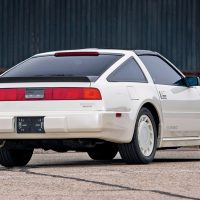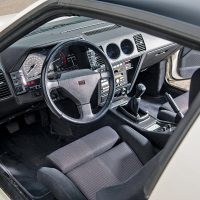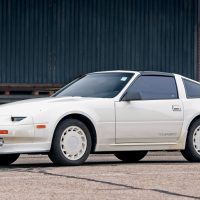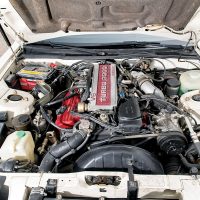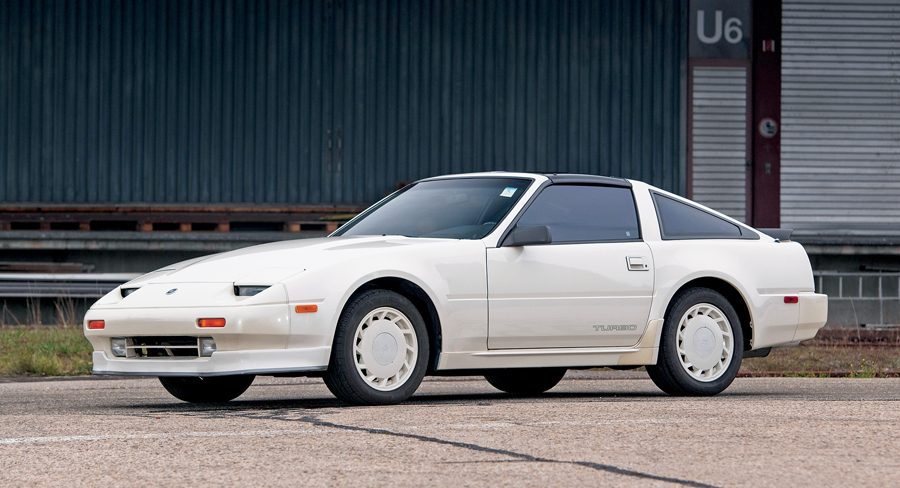
Everyone has a Z-car story. If you didn’t own one yourself, you knew someone who did. Datsun (later Nissan) built an affordable 2-seat fastback sports car with respectable power and handling — and enthusiasts bought them in large numbers.
However, the evolution of the Z-car is a cautionary tale for automakers because Nissan was too quick to listen to focus groups of sedan buyers.
By 1974, the single-year 260Z came with a 2+2 version that destroyed the roofline. By the end of the 1970s the corporate planners had turned the once-purposeful Z-car into a T-topped 4-seat agglomeration of malaise called the 280ZX.
Never Gonna Give You Up
Nissan tried to bring the Z-car back up to speed in stages, first by installing Japan’s first-ever mass-market V6 engine to create the 300ZX.
The new Z31 body was similar to the old 280ZX body. The 300ZX got back some horsepower, but it wasn’t enough. There had been a 280ZX Turbo since the early 1980s, and Nissan continued with a turbo V6, eventually working the engine up to 205 horsepower and 227 ft-lb of torque.
The last examples of the Z31 body style were built in 1988 and sold as 1988/1989 models. The new Z32 body arrived in the spring of 1989 as a 1990 model year, and it was a dramatic improvement. Few have ever lamented the departure of the Z31.
What’s a Shiro?
As a last hurrah, Nissan created the Shiro Special for the 1988 model year. They built 1,002 of them — all painted pearlescent “Moonglow” white. “Shiro” means white in Japanese.
The Shiro was a performance model, and Nissan deserves big thumbs-up for the effort.
They chucked 125 pounds of junk such as power seats and digital dashboards onto the factory floor and replaced it all with lightweight Recaro seats, old-fashioned gauges and an uprated performance suspension.
The Shiro came with 5% stiffer springs, along with bigger sway bars, Koni shocks, viscous limited-slip differential, an air dam and a 5-speed manual transmission. No automatics allowed.
Don’t go thinking the Shiro Special was any kind of factory race car, however. Buyers still got air conditioning, cruise control, power windows and mirrors — and those damn T-tops.
Buyers also paid a hefty premium for getting rid of the luxury items. The 1988 300ZX Turbo retailed for about $21,399, while a Shiro stickered at $25,349.
Even with the performance premium, the Shiro was a very good deal in its day. In 1988, you would have to lay down an additional $8,000 on top of the Shiro price to get about the same horsepower from a Porsche 944 Turbo. The Mazda RX-7 turbo matched the price of the base 300ZX Turbo closely, but was down 20 horsepower compared to the Nissan.
All Things Must Pass
When the next-generation Z32 300ZX Twin Turbo arrived in 1989, it came with 300 horsepower and 283 ft-lb of torque, but the price had gone up to $33,000. Still, Nissan had raised the bar and the older cars were obsolete the moment the first of the 1990s drove off the boat.
Nissan built the Z32 until 2000, then took a break and once again came back with a sports car for the new decade in the 350Z.
The 30 years since the Z31 became last year’s model have not been kind to their values. As is often the case, collectors gravitated to the purer early models, and drivers wanted the more up-to-date later models. A 300ZX from this era usually trades well below $10,000, and the turbos barely peak above that level.
The sale that prompted this column is an anomaly, based on extremely low mileage and impeccable original condition. At RM Sotheby’s March 29–30 auction in Fort Lauderdale, FL, an entirely original 1988 Shiro from the Youngtimer Collection with just 29,981 miles showing sold for $26,400.
That’s not as high a price as you might think. Right now there’s another 1988 Shiro on offer at Hemmings for $15,500. That’s in line with the SCM Pocket Price Guide median of $12,000 for this generation of 300ZX Turbo — plus a little more for the Shiro package.
That car has 129,000 miles on the clock, and a long list of recent maintenance work. If the seller noticed this auction sale, he’s likely to stick to his asking price. The $10,900 difference is entirely down to mileage.
Then again, two other Youngtimer 300ZX models went to the same auction. A 1991 Twin Turbo painted in Black Pearl with 2,356 miles went for $66,000 (Lot 3007), and a 1990 example (with a kickin’ in-car cell phone) showing 7,900 miles sold for $44,000 (Lot 3012). It just goes to show that the Z32 models are always likely to be the prettiest of the Nissan girls at the dance, while the Z31 will remain affordable. ♦
